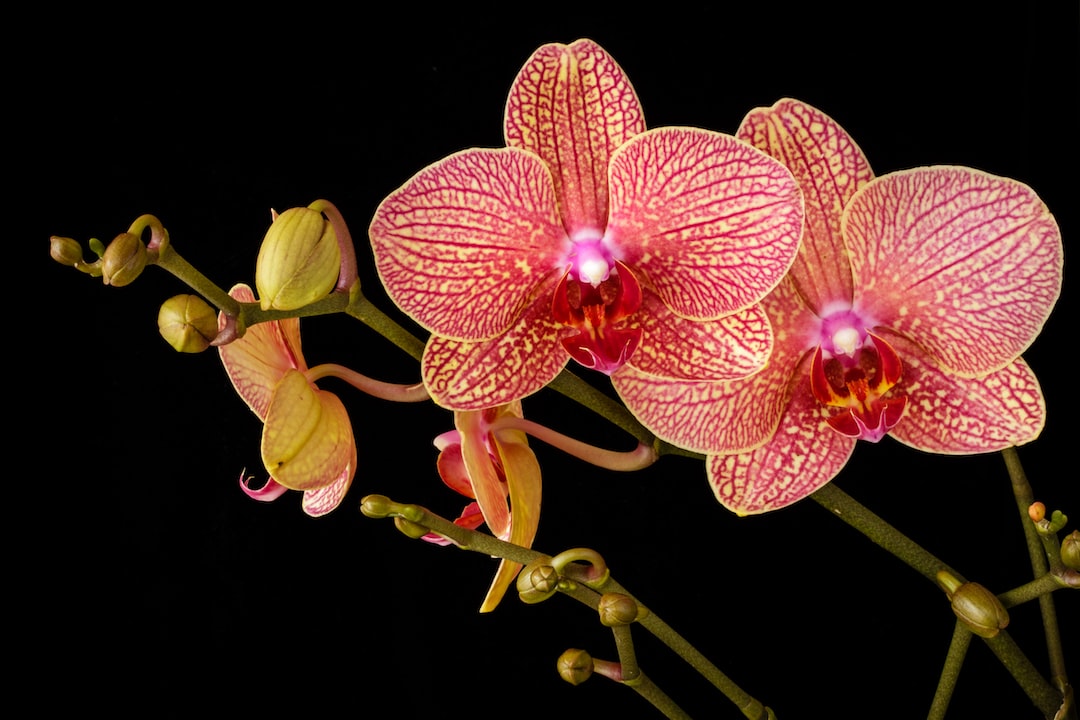The Secret to Healthy Orchids: Understanding the Importance of Root Growth and Repotting featuring Orchid Roots Growing Out of the Pot

Orchids are known for their beautiful and exotic flowers, but their root system is just as important for their overall health and growth. Orchid roots play a crucial role in absorbing water and nutrients from the environment, anchoring the plant in its pot or growing medium, and storing energy for future growth. Over time, orchid roots can become overcrowded or damaged, which is why repotting is necessary to ensure the plant’s continued health and vitality.
Repotting is the process of transferring an orchid from its current pot or growing medium to a new one. This is typically done every one to two years, depending on the type of orchid and its growth rate. Repotting allows for the inspection and removal of any unhealthy or dead roots, as well as the opportunity to provide fresh growing medium that will support the plant’s future growth.
Key Takeaways
- Orchid root growth and repotting are essential for maintaining healthy orchids.
- Healthy orchid roots are crucial for the overall health and growth of the plant.
- Signs of unhealthy orchid roots include discoloration, mushiness, and lack of growth.
- Potting mix plays a significant role in orchid growth and should be chosen carefully.
- Choosing the right pot for your orchids is important for proper drainage and airflow.
- Repotting your orchids should be done carefully and step-by-step.
- Maintaining healthy orchid roots requires proper watering, fertilization, and monitoring.
- Common mistakes to avoid when repotting orchids include overwatering and damaging the roots.
- Troubleshooting common orchid root problems involves identifying the issue and taking appropriate action.
- Healthy root growth and repotting are key to thriving orchids.
The Importance of Healthy Orchid Roots
Healthy roots are essential for the overall health and well-being of an orchid. They are responsible for absorbing water and nutrients from the environment, which are necessary for the plant’s growth and development. Without healthy roots, an orchid will struggle to thrive and may eventually die.
Unhealthy roots can have a detrimental effect on the entire plant. If the roots are damaged or diseased, they will not be able to absorb water and nutrients effectively, leading to stunted growth and poor flowering. Additionally, unhealthy roots can become a breeding ground for pests and diseases, further compromising the plant’s health.
Signs of Unhealthy Orchid Roots
There are several signs that indicate an orchid has unhealthy roots. One common sign is discoloration. Healthy orchid roots should be white or greenish-white in color. If the roots appear brown, black, or mushy, it is a clear indication that they are unhealthy.
Another sign of unhealthy roots is a foul odor. Healthy orchid roots should not have a strong smell. If the roots emit a foul odor, it is likely a sign of root rot, which is a serious condition that can quickly spread and kill the plant.
In addition to discoloration and odor, unhealthy roots may also be shriveled or have a slimy texture. These signs indicate that the roots are not absorbing water properly and are in need of immediate attention.
Understanding the Role of Potting Mix in Orchid Growth
| Metrics | Values |
|---|---|
| pH level | 5.5-6.5 |
| Water retention capacity | 60-70% |
| Aeration capacity | 30-40% |
| Organic matter content | 50-70% |
| Nutrient content | Low to moderate |
The potting mix used for orchids plays a crucial role in their growth and health. Orchids are epiphytic plants, which means they naturally grow on trees or rocks rather than in soil. Therefore, traditional potting soil is not suitable for orchids.
Instead, orchids require a specialized potting mix that provides good drainage and aeration while still retaining some moisture. The most common type of potting mix for orchids is made up of a combination of bark, sphagnum moss, and perlite or vermiculite.
Different types of potting mix can impact root growth in different ways. For example, a mix with larger pieces of bark will provide more air circulation to the roots, which can be beneficial for certain types of orchids. On the other hand, a mix with finer particles will retain more moisture, which may be better suited for orchids that prefer higher humidity.
How to Choose the Right Pot for Your Orchids
Choosing the right pot for your orchids is essential for their overall health and growth. There are several types of pots available for orchids, including plastic pots, clay pots, and wooden baskets.
Plastic pots are lightweight and retain moisture well, making them a popular choice for many orchid growers. However, they do not provide as much air circulation as other types of pots, so it is important to monitor the moisture levels and adjust watering accordingly.
Clay pots are porous and allow for good air circulation, which can be beneficial for orchids that prefer drier conditions. However, they also dry out more quickly, so they may require more frequent watering.
Wooden baskets are another option for orchid pots. They provide excellent air circulation and drainage, but they can also dry out quickly. Wooden baskets are often used for orchids that prefer high humidity and frequent watering.
When choosing a pot for your orchids, it is important to consider the specific needs of the plant. Factors such as the type of orchid, its growth habits, and the environmental conditions in your home or greenhouse should all be taken into account.
Step-by-Step Guide to Repotting Your Orchids

Repotting an orchid may seem like a daunting task, but with the right tools and techniques, it can be a straightforward process. Here is a step-by-step guide to repotting your orchids:
1. Choose the right time: The best time to repot an orchid is when it is not in bloom or actively growing. This is typically during the dormant period, which varies depending on the type of orchid.
2. Gather your supplies: You will need a new pot or basket, fresh potting mix, scissors or pruning shears, and a clean workspace.
3. Remove the orchid from its old pot: Gently tap the sides of the pot to loosen the roots. Carefully lift the plant out of the pot, taking care not to damage the roots.
4. Inspect the roots: Examine the roots for any signs of damage or disease. Trim away any dead or unhealthy roots using clean scissors or pruning shears.
5. Prepare the new pot: Fill the new pot with fresh potting mix, leaving enough space for the roots to spread out comfortably.
6. Place the orchid in the new pot: Position the orchid in the center of the pot, making sure the roots are spread out evenly. Add more potting mix around the roots, gently pressing it down to secure the plant.
7. Water and fertilize: After repotting, water the orchid thoroughly to settle the potting mix. Allow any excess water to drain away. Wait a few days before resuming regular watering and fertilizing.
Tips for Maintaining Healthy Orchid Roots
Maintaining healthy roots is essential for the long-term health and vitality of your orchids. Here are some tips to help you keep your orchid roots in optimal condition:
1. Proper watering: Orchids should be watered thoroughly but infrequently. Allow the potting mix to dry out slightly between waterings to prevent root rot. Avoid overwatering, as this can suffocate the roots and lead to fungal infections.
2. Fertilization: Orchids require regular fertilization to provide them with the necessary nutrients for growth and flowering. Use a balanced orchid fertilizer and follow the instructions on the label for proper application.
3. Air circulation: Good air circulation is important for preventing fungal infections and promoting healthy root growth. Avoid crowding your orchids together and provide adequate space between plants.
4. Light levels: Orchids require bright, indirect light to thrive. Place your orchids near a window with filtered sunlight or provide artificial grow lights if natural light is limited.
5. Temperature and humidity: Most orchids prefer warm temperatures and high humidity. Maintain a temperature range of 60-80°F (15-27°C) during the day and slightly cooler temperatures at night. Use a humidifier or place a tray of water near your orchids to increase humidity levels.
Common Mistakes to Avoid When Repotting Orchids
While repotting orchids is a necessary task, there are some common mistakes that people make that can impact the health of the plant. Here are a few mistakes to avoid:
1. Using the wrong potting mix: Using the wrong type of potting mix can lead to poor drainage or excessive moisture retention, both of which can be detrimental to orchid roots. Make sure to use a specialized orchid potting mix that provides good drainage and aeration.
2. Overwatering: Overwatering is one of the most common mistakes made when caring for orchids. Orchids prefer to dry out slightly between waterings, so it is important not to water them too frequently. Always check the moisture level of the potting mix before watering.
3. Repotting at the wrong time: Repotting an orchid at the wrong time can cause unnecessary stress to the plant. It is best to repot during the dormant period or when the plant is not actively growing or blooming.
4. Damaging the roots: When removing an orchid from its old pot, it is important to be gentle and avoid damaging the roots. Rough handling or pulling on the roots can cause them to break or become injured, which can hinder their ability to absorb water and nutrients.
Troubleshooting Common Orchid Root Problems
Despite your best efforts, problems with orchid roots can still occur. Here are some common problems that can affect orchid roots and how to address them:
1. Root rot: Root rot is a fungal infection that occurs when the roots are consistently overwatered or exposed to excessive moisture. To address root rot, remove any affected roots and repot the orchid in fresh potting mix. Adjust your watering routine to prevent future occurrences.
2. Overwatering: Overwatering can suffocate orchid roots and lead to root rot. If you suspect overwatering, allow the potting mix to dry out before watering again. Adjust your watering schedule to ensure the roots have time to dry out between waterings.
3. Underwatering: Underwatering can cause the roots to dry out and become dehydrated. If you suspect underwatering, increase the frequency of your watering routine. Monitor the moisture level of the potting mix and adjust as needed.
4. Pests: Pests such as aphids, mealybugs, and scale insects can infest orchid roots and cause damage. If you notice any signs of pests, such as sticky residue or small insects, treat the plant with an appropriate insecticide or insecticidal soap.
The Key to Thriving Orchids Lies in Healthy Root Growth and Repotting
In conclusion, healthy root growth and proper repotting are essential for the overall health and vitality of orchids. Unhealthy roots can hinder the plant’s ability to absorb water and nutrients, leading to stunted growth and poor flowering. Repotting allows for the inspection and removal of any unhealthy or dead roots, as well as the opportunity to provide fresh potting mix that will support the plant’s future growth.
By understanding the signs of unhealthy roots, choosing the right potting mix and pot, following proper repotting techniques, and maintaining healthy root care practices, you can ensure that your orchids thrive and continue to produce beautiful flowers for years to come. Take the time to monitor your orchids’ root health regularly and make adjustments as needed to promote optimal growth and vitality. With proper care, your orchids will reward you with stunning blooms and a vibrant display of beauty in your home or garden.



